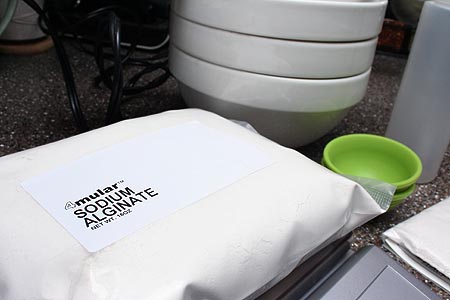
The first time I’d seen or even heard of Molecular Gastronomy was the now infamous episode of Anthony Bourdain’s No Reservations “Decoding Ferran Adria.” I had no idea who Adria was, nor had I heard of his world renouned restaurant ElBulli, neatly tucked away in Roses, Spain. The episode changed my entire perception of how creative you can actually be in the kitchen. And being creative is all I’m ever after, in everything I do. It’s the one reason I’m as addicted to cooking as I am, and that includes brewing.
Originally filmed for his Food Network show “A Cook’s Tour” (and apparently only ever airing on Food Network Canada) “Decoding Ferran Adria” is now the most talked about episode of No Reservations. It was so popular, the single episode appeared on DVD within a month of it’s release. You can buy it on Amazon.com here or watch it online here. Shortly after the episode aired, I watched it again, and again, and again.
I sat in awe as he ate things I’d never even heard of. carrot air, pasta-less pea ravioli, apple caviar, cured tuna belly sliced so thin you need tweezers to eat it. And as far as I knew, the only way to ever experience food like this was a reservation to ElBulli, which – as it turns out – is harder to get than an admission of guilt from OJ Simpson.
So imagine the ray of sunshine that shined upon me the day I read this post from Jo at My Last Bite, a blog dedicated only to good food, not bad. Like most of us, Jo is a very good home chef in her own right. And after taking a class on molecular cooking, she posted photos and recipes from it. I couldn’t believe a class like that even existed, let alone available not that far away from my door. Jo posted links to online stores that sold the special food-grade chemistry that’s needed to accomplish these dishes, as well as her step-by-step instructions on how to actually do it in your own kitchen.
If you’ve listened to Episode 30 of My Life as a Foodie, you know the rest. I’m out to try this myself. And if I’m successful at it, dinner parties may never be the same again.
Chemistry in hand, equipment at the ready, I recently attempted my first dish using the tricks and theories laid out by Herve This, Ferran Adria, Grant Achatz, and the like. Apple Caviar seemed like the most approachable thing to try. Jo had already created Pink Grapefruit Caviar, the steps were there, as was her recipe.
Since I wanted this to be a bit different, I decided to infuse 9 ounces of fresh apple juice with sprigs of fresh rosemary from my garden. This sat all day, making sweet sweet rosemary/apple love.
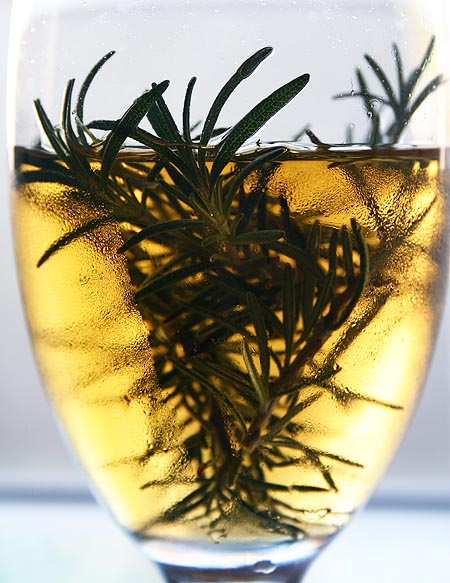
I separated the rosemary from the apple juice, tasted a bit of it to make sure the balance was right, then added 1 gram of Sodium Alginate to the juice and blended it with an immersion blender in a bowl for a full minute. The result was a foamy, gooey liquid that seemed to resemble the slimy stuff from Ghostbusters, but smelled like rosemary and apples.

Once strained, I let it set until the foamy stuff settled. Then I put the mix into a plastic squeeze bottle. Per Jo’s instructions, I mixed 3 grams of Calcium Chloride with 18 ounces of cold water. This is the calcium bath that will make the outsides of the finished caviar hard enough to hold the goo together. It seems that alginate makes a gel out of any juice it’s mixed with, but on it’s own it’s just a gel. In the presence of Calcium, it holds together.
OK, kids – everyone in the pool!
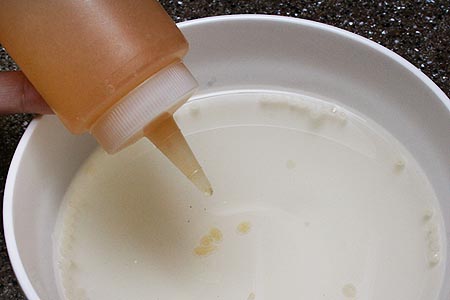
Some of you who are old like me will remember Sea Monkeys when you were a kid. If you do, you’ll recall the excitement of staring at that little jar of water that you’ve added dehydrated brine shrimp to, waiting for the little shrimp to come to life and start dancing around in the water. Well, if you recall the excitement of that, you’ll know just how excited I was as I dropped these balls of apple gel into this calcium bath and started seeing these perfectly round balls forming. It actually works.
After a minute in the calcium bath, I used my small metal strainer to carefully fish the caviar balls out of solution, and into a bowl full of fresh, clean water. This rinses the calcium off of the finished caviar. Out of that bath, gently dried on a clean towel, and into a serving spoon. I garnished it with a small rosemary flower.
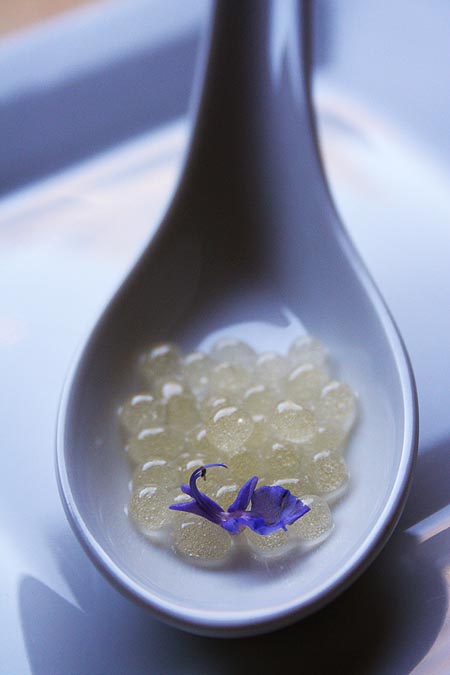
They were gentle balls of rosemary goodness that squirted apple juice in your mouth as you ate them. It was magic, and I was instantly hooked. Sure, there’s attention to detail involved, and patience – but it’s all worth it. Anytime you’re doing something you really love doing, and you’re being creative – that’s not work. It’s a genuine feeling of zen for me.
I plan on doing this again, with less of an infusion (just a bit too much rosemary this time). After that, I’m going to patiently wait for the next molecular cooking class being held in Los Angeles (February 22nd) so I can get some hands-on professional training from Chef Michael Young. After that, it’s on to foams, pea ravioli, and God knows what else.
Stay tuned, and check out Jo’s blog for her continued adventures in Molecular Cooking. And by the way, don’t ever hire a cat for a sous chef. They’re worthless in the kitchen, and they sleep on the job.
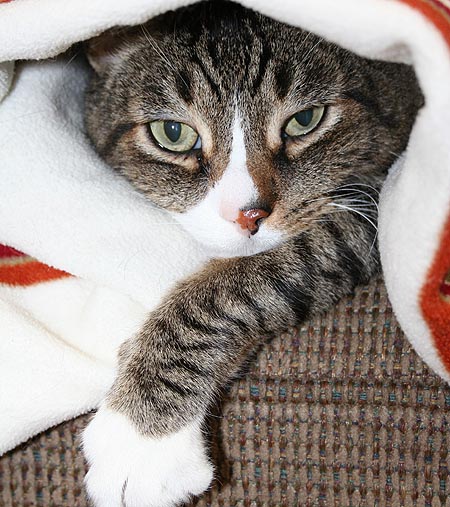
Share this Post
33 Comments
Comments RSS TrackBack Identifier URI
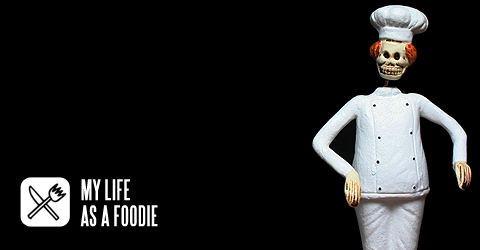






Phil, The photos are absolutely stunning! I hope you submitted them to Tastespotting, Foodgawker, etc!! People need to see your beautiful work.
And thank you for your kind words. It’s so fun to share this enchanting “molecular” world, and YOU make me want to keep pushing it further.
: )
p.s. Sea Monkeys!! LOL
Phil,
That’s awesome! I can’t imagine how good those were … And your photos are gorgeous!
And I know just who you can hire to replace that no-good sous chef of yours! 🙂
Philip!!!! AMAZING!!!!!!!!!!! I love the pic with the flower…. seriously… wow… Yes I HAVE to order one of these kits… Cheers man!!!!1 wow….
Wow , this is so amazing. Well done, I am inspired!
you are blowing my mind
I have only seen two episodes of No Reservations and that episode was one of them. Very nice writeup and photos. Cheers!
This is awesome. Thanks for inspiring me. Will check out the NR episode immediately. I always love when they use molecular gastronomy techniques on Top Chef — Richard was fun to watch.
Can’t wait to hear about the classes!
Also…rosemary flower was a great touch 🙂
That technique is a great way to do something totally different and completely change the texture and flavor combination people are used to. The first I heard about it was from Homebrew Chef, Sean Paxton. His “Strawberries and Cream Deconstructed” that uses the same method is here:
http://www.homebrewchef.com/StrawberriesandCreamDeconstructed.html
Thanks for your responses everyone. I’m overwhelmed, to be honest. It was a very simple process, thanks to Jo’s guidance. Her posts at My Last Bite are far more detailed, and include links to where you can buy the stuff to do this, if you want to try it yourself. http://www.mylastbite.com
Kyle, I agree about Richard. He was really exciting to watch. My favorite was when he was paired with Eric Ripert for the Final Elimination and he showed him some of his techniques and Ripert was beside himself. How great did he feel after that? Stephanie deserved the win, but I think that had to help take some of the sting away.
And Peter, thanks for the link. I’m a huge fan of Sean Paxton and the exciting things he does with food and beer. He’s been a great support for me. I’m looking forward to his beer/food pairing menu for The Bruery.
Cheers, and thanks again to everyone for your warm responses.
Phil
Nice work Phil! I’m going to live vicariously through your site since I know that the wife would probably kill me if I tried any of this in the kitchen.
Phil – great writeup here, and I love the photos that add some pop to it all. Keep up on the blogging, cooking and brewing.
Nothing more to hear from me… Sounds really cool… Iike the idea of calling it caviar. Can you make one that tastes like IPA?
[…] check out Phil’s blog (including his beautiful molecular cooking […]
Ah, it’s cool seeing you so excited by this! Awesome photography.
Gosh, your molecular pics are so yummy! I wished I can get all those products to make them. I’m not sure if the package will reach me without being confiscated by customs… 😦
Your cat is adorable 😀 I wonder why you don’t make ‘molecular paws’..
off topic, but your link at the side is incorrect http://alineaathome.com/ is what it should be
Thanks Robert. 🙂 Fixed that.
No offense or anything, whatever floats your boat, but most classically trained chefs/many in general really dislike the idea of molecular gastronomy. For one you’re eating stuff that really isn’t “edible” and I can’t really explain the second but chefs tend think it takes away from true cooking. I don’t know it just gets to some of us, maybe to gimmicky. Don’t mean to diss you just playing devil’s advocate.
Hi Taylor, thanks for checking out my post, and for your comments.
I totally understand where you’re coming from. And I can see where some might see the gimmickry in all of this. It’s certainly not for everyone. But it is for me, as well as a host of others who pack restaurants like El Bulli, Alinea, WD-50 night after night. More than anything, it’s fun for me to be able to do prepare dishes like this at home, and experience something new.
As for the food not being “edible” I have to say that’s far from the truth. Not sure where you’re getting that information from. To begin, there is a scant amount of additives to any dish that we’re preparing, and everything being added is food-grade. Additives like alginate, gelatin, lecithin, calcium chloride — all natural derivatives of algae, soy, and numerous things found in the sea. When the day comes that elements from the sea are deemed inedible, may as well go ahead and kill me. 😉
Again, I appreciate your comments Taylor. It’s healthy to be able to have these discussions, especially classical versus modern preparations.
Cheers!
Phil
Taylor’s comment made me think of Chef Eric Ripert, who is undeniably one of the world’s most preeminent “classically trained” chefs.
While making a guest appearance on an episode of Top Chef, Ripert was watching one of the contestants working with molecular gastronomy and said…
“The day you stop learning anymore is the day you’re such an egomaniac you’re blind.”
Enough said!
First off let me say that everything was beautifully photographed.
I have been searching around for someone elses experiences with spherification at home ever since watching Jose’ Andres make his liquid olives on Craig Ferguson.
Thanks for checking out the post, and for your kind words too!
I know what you mean. I scoured the internet for information on molecular gastronomy, but there seemed to be very few articles available that described how simple it was, and how achievable this is at home.
Then, I found Jo at My Last Bite! Things changed dramatically after that.
I’m so happy to see this dish attempted. I have a book of downloaded recipes using hydocolloids; one of them was called “Coke a Cola Caviar”, using a very similar porcedure involving reduced coke and a hyrocolloid being dropped with an eye-dropper into a calcium chloride bath. Although the book contained no photos, I imagined the results to be astonishing and just as exciting as your rosemary and apple experiment. Having no access to the necessary ingredients, seeing your beautiful creation made me smile….
Too bad there are no restaurants that do this around me. I’d like to try it but I don’t have the time (or knowledge) to do it myself.
What is “molecular” gastronomy as a “cuisine”? Pretentious prima donnas cluttering what we consume with unnecessary chemical crap to egotistically “impress” us with their cleverness and cuteness.
The idea that this is innovative and lofty is the biggest load imaginable. These are many of the same thing that big corporations do to the factory food we buy in the grocery stores. It’s now being done by bored, obnoxious two-bit chefs who don’t understand their valuable art and craft, or appreciate importance of its integrity. It’s obnoxiously pretentious novelty.
Here we’re trying to get people to have an appreciation for GOOD, LOCALLY SOURCED, FRESH ORGANIC food, to elevate the standards of gastronomy in America… And now we have these irresponsible clowns sending the opposing message: “It’s fun and hip to eat food modified with chemical crap!”
Know what? No, it actually isn’t. It’s like a throw-away done for kids to get their attention. Grow up already and become a real professional with some discernment, integrity, taste, and standards.
Nothing is more irritating, because food is not just a luxury–it’s a NECESSITY for people, and its QUALITY is essential for HEALTH. A good APPRECIATION for that quality which is apparent in natural food is a GOOD THING to develop within people., as elevated standards in quality of food lead to healthier people.
Here’s a novel idea: What to dazzle people with fantastic food:? Then actually UNDERGO THE DISCIPLINE OF LEARNING TO COOK FANTASTICALLY, rather than pretending to be some kind of cheesy side-show magician. In the long run, you’ll be better off for it, and so will everyone else.
Last point… I think it’s really remarkably telling that you developed a passion for this from watching a show on the Food Network. How absurd is that? You developed a passion for a cuisine by watching a PR piece for it ON TV?? Food is a personal SENSORY experience: You didn’t even experience it at all, you just saw a presentation about it. Clearly your interest had nothing to do with being impressed with the actual sensory quality of the food itself. How tertiary is that to what food is even ABOUT? You all but admit it’s about nothing but pure disconnected novelty. Don’t the people who have to eat your food deserve something more than that? As a professional don’t you owe them more integrity than that?
The TV thing just takes the cake. It’s like someone saying they developed a passion for painting after reading a description about what a painting looked like. It’s kind of weird and irrelevant unless you actually are hooked by SENSORY EXPERIENCE that it’s ALL ABOUT: If you SEE the painting and are taken in by what you see that is at least something legitimate. If it’s a PAINTING and you have no idea what it actually LOOKS LIKE, you aren’t really passionate about THE PAINTING, you are passionate about THE IDEA that you think sounds cute. You essentially say the same thing is the case for you and these novelty food presentation methods. It’s not about the ESSENCE OF THE FOOD, it’s about an idea that you think is cute.
What a deluded waste. Please, come back down to earth and start learning real cooking, and what it’s all about. Again, you’ll be better off for it in the long run, I promise you.
JK, I appreciate your passion here, but it might be a bit misdirected.
I think you should have probably done a little bit of research on this site, read some of my other posts, listen to my podcast, and perhaps look into the elements used to create molecular dishes. You would have found the following true:
1) I’m not a professional chef. I’m an accomplished home cook, doing what I can to share the various styles of cuisine available to my friends and family. I’m very accomplished at some disciplines as well. I can make confit, pickle, cure and smoke, and have a great passion for all things French.
Let me repeat – I AM NOT A PROFESSIONAL CHEF. But if I were, a job at several of the best restaurants in the world (see Alinea, The Fat Duck, El Bulli) would certainly require me to know molecular gastronomy techniques. Perhaps the fact that you don’t know them yourself is what’s getting to you. You’re not alone, however. I know. I’ve talked to many professionals who hate the idea of this style of cooking. They all say the same things. I wonder, however, if they’d reject the idea of working in one of those kitchens, under the direction of Blumenthal, Adria, or Achatz. Somehow, I doubt it.
2) I’m a firm proponent of farmers markets, eating locally and organically. Health issues are a strong foundation of my podcast, and my blog. In fact, I use the freshest ingredients I can get my hands on for every single one of the dishes I make for my family and friends – some of which I grow myself.
3) Molecular cooking involves the use of natural elements – not chemicals. A little research on this may have prevented you from making such radical statements. Seaweed, soy lecithin, various forms of algae, and animal gelatin all play a role in creating molecular dishes.
I certainly hope you put the kind of passion in your cooking as you did in the (not one but) TWO comments you left here. And a bit more research as well.
Thanks for sharing. Share is caring after all.
Congratulations on a great race! I was tracking you yesterday and I was really happy to see your great time! I cant wait to hear the full details.
http://www.modernistpantry.com/sodium-alginate.html?gclid=CLKI_N_R3LUCFQ6xnQodfEIAPQ
You should check out this site. Lots of cool supplies for this type of cooking.
All large purchases are always intimidating, especially if you are uninformed about the industry.
One of the scariest purchases is buying cars. Many people fear
they are getting ripped off and you surely don’t want that. Avoid buying a lemon by looking through these great tips and tricks regarding car purchases.
I do not know whether it’s just me or if everybody else encountering problems with your blog. It appears as if some of the text within your content are running off the screen. Can somebody else please provide feedback and let me know if this is happening to them as well? This might be a problem with my web browser because I’ve had this happen before.
Thanks
Hello this is kind of of off topic but I was wanting to know
if blogs use WYSIWYG editors or if you have to manually code with HTML.
I’m starting a blog soon but have no coding experience so I wanted to get guidance from someone with experience. Any help would be greatly appreciated!